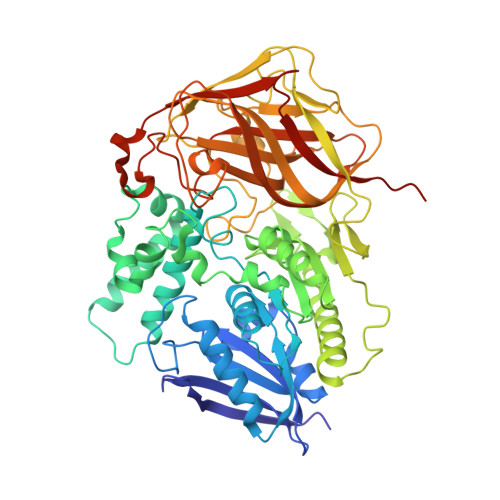Subunit stabilization and polyethylene glycolation of cocaine esterase improves in vivo residence time.
Narasimhan, D., Collins, G.T., Nance, M.R., Nichols, J., Edwald, E., Chan, J., Ko, M.C., Woods, J.H., Tesmer, J.J., Sunahara, R.K.(2011) Mol Pharmacol 80: 1056-1065
- PubMed: 21890748
- DOI: https://doi.org/10.1124/mol.111.074997
- Primary Citation of Related Structures:
3PUH, 3PUI - PubMed Abstract:
No small-molecule therapeutic is available to treat cocaine addiction, but enzyme-based therapy to accelerate cocaine hydrolysis in serum has gained momentum. Bacterial cocaine esterase (CocE) is the fastest known native enzyme that hydrolyzes cocaine. However, its lability at 37°C has limited its therapeutic potential. Cross-linking subunits through disulfide bridging is commonly used to stabilize multimeric enzymes. Herein we use structural methods to guide the introduction of two cysteine residues within dimer interface of CocE to facilitate intermolecular disulfide bond formation. The disulfide-crosslinked enzyme displays improved thermostability, particularly when combined with previously described mutations that enhance stability (T172R-G173Q). The newly modified enzyme yielded an extremely stable form of CocE (CCRQ-CocE) that retained greater than 90% of its activity after 41 days at 37°C, representing an improvement of more than 4700-fold over the wild-type enzyme. CCRQ-CocE could also be modified by polyethylene glycol (PEG) polymers, which improved its in vivo residence time from 24 to 72 h, as measured by a cocaine lethality assay, by self-administration in rodents, and by measurement of inhibition of cocaine-induced cardiovascular effects in rhesus monkeys. PEG-CCRQ elicited negligible immune response in rodents. Subunit stabilization and PEGylation has thus produced a potential protein therapeutic with markedly higher stability both in vitro and in vivo.
Organizational Affiliation:
Department of Pharmacology, University of Michigan, Ann Arbor, MI 48109, USA.
















